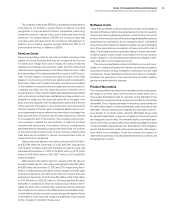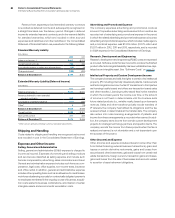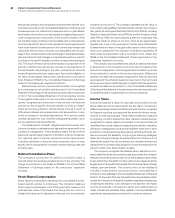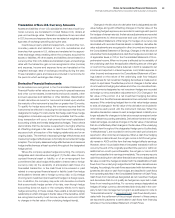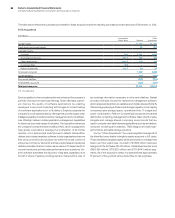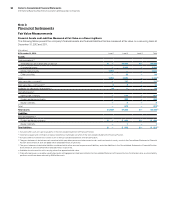IBM 2012 Annual Report Download - page 87
Download and view the complete annual report
Please find page 87 of the 2012 IBM annual report below. You can navigate through the pages in the report by either clicking on the pages listed below, or by using the keyword search tool below to find specific information within the annual report.
86 Notes to Consolidated Financial Statements
International Business Machines Corporation and Subsidiary Companies
86
Estimated Residual Values of Lease Assets
The recorded residual values of lease assets are estimated at the
inception of the lease to be the expected fair value of the assets at
the end of the lease term. The company periodically reassesses the
realizable value of its lease residual values. Any anticipated increases
in specific future residual values are not recognized before realiza-
tion through remarketing efforts. Anticipated decreases in specific
future residual values that are considered to be other-than-temporary
are recognized immediately upon identification and are recorded as
an adjustment to the residual value estimate. For sales-type and
direct-financing leases, this reduction lowers the recorded net
investment and is recognized as a loss charged to financing income
in the period in which the estimate is changed, as well as an adjust-
ment to unearned income to reduce future-period financing income.
Common Stock
Common stock refers to the $.20 par value per share capital stock
as designated in the company’s Certificate of Incorporation. Trea-
sury stock is accounted for using the cost method. When treasury
stock is reissued, the value is computed and recorded using a
weighted-average basis.
Earnings Per Share of Common Stock
Earnings per share (EPS) is computed using the two-class method.
The two-class method determines EPS for each class of common
stock and participating securities according to dividends and dividend
equivalents and their respective participation rights in undistributed
earnings. Basic EPS of common stock is computed by dividing net
income by the weighted-average number of common shares out-
standing for the period. Diluted EPS of common stock is computed
on the basis of the weighted-average number of shares of common
stock plus the effect of dilutive potential common shares outstanding
during the period using the treasury stock method. Dilutive potential
common shares include outstanding stock options, stock awards and
convertible notes.
Note B.
Accounting Changes
Standards Implemented
In February 2013, the Financial Accounting Standards Board (FASB)
issued additional guidance regarding reclassifications out of AOCI.
The new guidance requires entities to report the effect of significant
reclassifications out of AOCI on the respective line items in net
income unless the amounts are not reclassified in their entirety to
net income. For amounts that are not required to be reclassified in
their entirety to net income in the same reporting period, entities are
required to cross-reference other disclosures that provide additional
detail about those amounts. For the company, the new guidance is
effective prospectively for all interim and annual periods beginning
January 1, 2013 with early adoption permitted. The company elected
to early adopt the guidance. There was no impact in the consoli-
dated financial results as the guidance related only to additional
disclosures. See note L, “Equity Activity,” on pages 107 to 110 for
further information.
In July 2012, the FASB issued amended guidance that simplifies
how entities test indefinite-lived intangible assets other than goodwill
for impairment. After an assessment of certain qualitative factors, if
it is determined to be more likely than not that an indefinite-lived
intangible asset is impaired, entities must perform the quantitative
impairment test. Otherwise, the quantitative test is optional. The
amended guidance was effective for annual and interim impairment
tests performed for fiscal years beginning after September 15, 2012,
with early adoption permitted. The company elected to adopt this
guidance for its 2012 impairment testing of indefinite-lived intan-
gible assets performed in the fourth quarter. There was no impact
in the consolidated financial results.
In May 2011, the FASB issued amended guidance and disclosure
requirements for fair value measurements. These changes were
effective January 1, 2012 on a prospective basis. These amendments
did not have a material impact in the consolidated financial results.
In September 2011, the FASB issued additional disclosure
requirements for entities which participate in multi-employer pension
plans. The purpose of the new disclosures was to provide financial
statement users with information about an employer’s level of par-
ticipation in these plans and the financial health of significant plans.
The new disclosures were effective beginning with the full year 2011
financial statements. The company does not participate in any mate-
rial multi-employer plans. There was no impact in the consolidated
financial results as the changes relate only to additional disclosures.
In September 2011, the FASB issued amended guidance that sim-
plified how entities test goodwill for impairment. After an assessment
of certain qualitative factors, if it is determined to be more likely than
not that the fair value of a reporting unit is less than its carrying
amount, entities must perform the quantitative analysis of the goodwill
impairment test. Otherwise, the quantitative test(s) is optional. The
guidance was effective January 1, 2012 with early adoption permitted.
The company adopted this guidance for the 2011 goodwill impairment
test. There was no impact in the consolidated financial results.
In June 2011, the FASB issued amended disclosure requirements
for the presentation of OCI and AOCI. OCI is comprised of costs,
expenses, gains and losses that are included in comprehensive
income but excluded from net income, and AOCI comprises the
aggregated balances of OCI in equity. The amended guidance elimi-
nated the option to present period changes in OCI as part of the
Statement of Changes in Equity. Under the amended guidance, all
period changes in OCI are to be presented either in a single continu-
ous statement of comprehensive income, or in two separate, but
consecutive financial statements. Only summary totals are to be
included in the AOCI section of the Statement of Changes in Equity.
In December 2011, the FASB deferred the requirement to present
reclassifications from AOCI on the face of the Consolidated State-
ment of Earnings. The changes were effective January 1, 2012 with
early adoption permitted. The company adopted the two statement
approach effective with its full year 2011 financial statements. There
was no impact in the consolidated financial results as the amend-
ments related only to changes in financial statement presentation.





